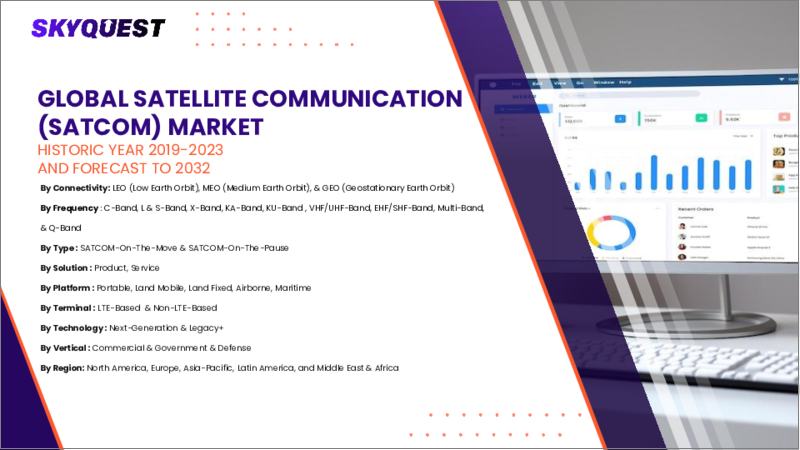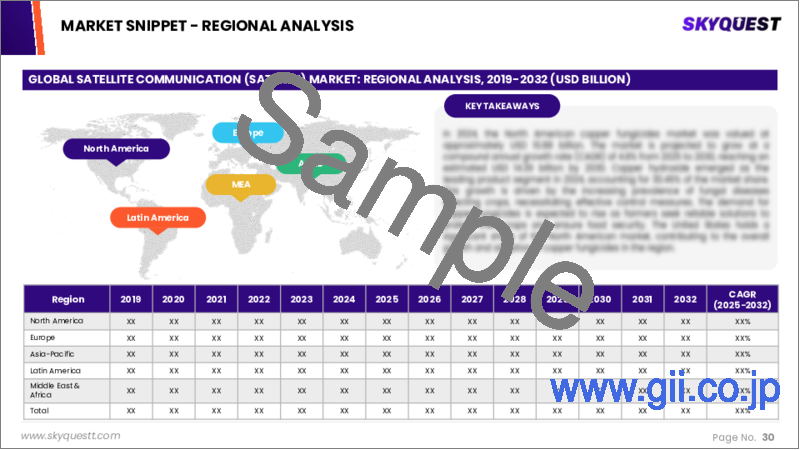|
|
市場調査レポート
商品コード
1628911
衛星通信(SATCOM)市場規模、シェア、成長分析、接続性別、周波数別、タイプ別、業界別、ソリューション別、プラットフォーム別、端末別、技術別、地域別 - 産業予測、2025~2032年Satellite Communication (SATCOM) Market Size, Share, Growth Analysis, By Connectivity (LEO, MEO/GEO), By Frequency (C-Band, L & S-Band), By Type, By Vertical, By Solution, By Platform, By Terminal, By Technology, By Region - Industry Forecast 2025-2032 |
||||||
|
|||||||
| 衛星通信(SATCOM)市場規模、シェア、成長分析、接続性別、周波数別、タイプ別、業界別、ソリューション別、プラットフォーム別、端末別、技術別、地域別 - 産業予測、2025~2032年 |
|
出版日: 2025年01月05日
発行: SkyQuest
ページ情報: 英文 290 Pages
納期: 3~5営業日
|
- 全表示
- 概要
- 目次
世界の衛星通信(SATCOM)市場規模は、2023年に232億米ドルと評価され、2024年の258億米ドルから2032年には603億2,000万米ドルに成長し、予測期間中(2025-2032年)のCAGRは11.2%で成長する見通しです。
人工衛星を活用して世界な通信リンクを確立する衛星通信は、テレビ、通信、ラジオ、軍事作戦などさまざまな分野で極めて重要な役割を果たしています。トランスポンダーを利用して無線信号を増幅・中継することで、通信衛星は地球の曲率によって生じるギャップを埋め、広大な距離の接続を容易にします。この技術は、高周波無線とマイクロ波周波数を使用し、信号が地理的な障壁を越えられることを保証します。潜在的な信号干渉を緩和するため、国際的な規制機関が周波数帯の割り当てを監督し、通信の信頼性を高めています。産業界がシームレスな通信を実現するためにこの技術への依存度を高める中、衛星通信システムの戦略的展開と管理は、多様なアプリケーションで効率的かつ中断のないサービスを維持するために不可欠となります。
目次
イントロダクション
- 調査の目的
- 調査範囲
- 定義
調査手法
- 情報調達
- 二次データと一次データの方法
- 市場規模予測
- 市場の前提条件と制限
エグゼクティブサマリー
- 世界市場の見通し
- 供給と需要の動向分析
- セグメント別機会分析
市場力学と見通し
- 市場概要
- 市場規模
- 市場力学
- 促進要因と機会
- 抑制要因と課題
- ポーターの分析
主な市場の考察
- 重要成功要因
- 競合の程度
- 主な投資機会
- 市場エコシステム
- 市場の魅力指数(2024年)
- PESTEL分析
- マクロ経済指標
- バリューチェーン分析
- 価格分析
- 技術分析
- 規制分析
- 特許分析
- ケーススタディ分析
- 貿易分析
衛星通信(SATCOM)市場規模:接続性別
- 市場概要
- LEO(低地球軌道)
- MEO/GEO(中軌道/静止軌道)
衛星通信(SATCOM)市場規模:周波数別
- 市場概要
- Cバンド
- LバンドとSバンド
- Xバンド
- KAバンド
- KUバンド
- VHF/UHFバンド
- EHF/SHFバンド
- マルチバンド
- Qバンド
衛星通信(SATCOM)市場規模:タイプ別
- 市場概要
- SATCOM- 移動中
- SATCOM- 一時停止
衛星通信(SATCOM)市場規模:業界別
- 市場概要
- 商業用
- 通信およびセルラーバックホール
- メディアとエンターテイメント
- ビジネスとエンタープライズ
- 運輸・物流
- 科学研究開発
- 航空
- 海洋
- 小売・消費者
- その他
- 政府と防衛
- 軍事
- 国土安全保障と緊急管理
衛星通信(SATCOM)市場規模:ソリューション別
- 市場概要
- 製品
- アンテナ
- トランシーバー
- パワーアンプ
- コンバータ
- ジャイロスタビライザー
- モデムとルーター
- 無線
- レドーム
- その他の製品
- サービス
- エンジニアリングと統合
- インストール
- 物流とメンテナンス
衛星通信(SATCOM)市場規模:プラットフォーム別
- 市場概要
- ポータブル
- 陸上移動
- 土地固定
- 空中
- 海事
衛星通信(SATCOM)市場規模ターミナル
- 市場概要
- LTEベース
- LTE非対応
衛星通信(SATCOM)市場規模:技術別
- 市場概要
- 次世代
- Legacy+
衛星通信(SATCOM)市場規模
- 北米
- 米国
- カナダ
- 欧州
- ドイツ
- スペイン
- フランス
- 英国
- イタリア
- その他欧州地域
- アジア太平洋地域
- 中国
- インド
- 日本
- 韓国
- その他アジア太平洋地域
- ラテンアメリカ
- ブラジル
- その他ラテンアメリカ地域
- 中東・アフリカ
- GCC諸国
- 南アフリカ
- その他中東・アフリカ
競合情報
- 上位5社の比較
- 主要企業の市場ポジショニング(2024年)
- 主な市場企業が採用した戦略
- 市場の最近の動向
- 企業の市場シェア分析(2024年)
- 主要企業の企業プロファイル
- 会社概要
- 製品ポートフォリオ分析
- セグメント別シェア分析
- 収益の前年比比較(2022-2024)
主要企業プロファイル
- L3Harris Technologies Inc.(US)
- Thales(France)
- RTX(US)
- General Dynamics Corporation(US)
- Cobham Satcom(Denmark)
- Honeywell International Inc.(US)
- Viasat, Inc.(US)
- Gilat Satellite Networks(Israel)
- Aselsan A.S(Turkey)
- Iridium Communication Inc.(US)
- Intellian Technologies Inc.(South Korea)
- ST Engineering(Singapore)
- SpaceX(US)
- Elbit Systems Ltd.(Israel)
- Campbell Scientific, Inc.(US)
- ND SatCom GmbH(Germany)
結論と推奨事項
Global Satellite Communication (SATCOM) Market size was valued at USD 23.2 billion in 2023 and is poised to grow from USD 25.8 billion in 2024 to USD 60.32 billion by 2032, growing at a CAGR of 11.2% during the forecast period (2025-2032).
Satellite communication, which leverages artificial satellites to establish global communication links, plays a pivotal role in various sectors including television, telecommunications, radio, and military operations. By utilizing transponders to amplify and relay radio signals, communication satellites bridge gaps created by the Earth's curvature, facilitating connectivity across vast distances. The technology employs high-frequency radio and microwave frequencies, ensuring that signals can traverse geographical barriers. To mitigate potential signal interference, international regulatory bodies oversee the allocation of frequency bands, enhancing the reliability of telecommunications. As industries increasingly depend on this technology for seamless communication, the strategic deployment and management of satellite communication systems will be vital for maintaining efficient and uninterrupted services across diverse applications.
Top-down and bottom-up approaches were used to estimate and validate the size of the Global Satellite Communication (SATCOM) market and to estimate the size of various other dependent submarkets. The research methodology used to estimate the market size includes the following details: The key players in the market were identified through secondary research, and their market shares in the respective regions were determined through primary and secondary research. This entire procedure includes the study of the annual and financial reports of the top market players and extensive interviews for key insights from industry leaders such as CEOs, VPs, directors, and marketing executives. All percentage shares split, and breakdowns were determined using secondary sources and verified through Primary sources. All possible parameters that affect the markets covered in this research study have been accounted for, viewed in extensive detail, verified through primary research, and analyzed to get the final quantitative and qualitative data.
Global Satellite Communication (SATCOM) Market Segmental Analysis
Global Satellite Communication (SATCOM) Market is segmented by Connectivity, Frequency, Type, Vertical, Solution, Platform, Terminal, Technology and region. Based on Connectivity, the market is segmented into LEO (Low Earth Orbit) and MEO/GEO (Medium Earth Orbit/Geostationary Earth Orbit). Based on Frequency, the market is segmented into C-Band, L & S-Band, X-Band, KA-Band, KU-Band, VHF/UHF-Band, EHF/SHF-Band, Multi-Band and Q-Band. Based on Type, the market is segmented into SATCOM-On-The-Move and SATCOM-On-The-Pause. Based on Vertical, the market is segmented into Commercial and Government & Defense. Based on Solution, the market is segmented into Product and Service. Based on Platform, the market is segmented into Portable, Land Mobile, Land Fixed, Airborne and Maritime. Based on Terminal, the market is segmented into LTE-Based and Non-LTE-Based. Based on Technology, the market is segmented into Next-Generation and Legacy+. Based on region, the market is segmented into North America, Europe, Asia Pacific, Latin America and Middle East & Africa.
Driver of the Global Satellite Communication (SATCOM) Market
The Global Satellite Communication (SATCOM) market is expected to experience significant growth driven by the increasing application of SATCOM technology across various sectors, particularly in agriculture and public safety. The demand for efficient data transfer from observational and navigational satellites is propelling the expansion of data communication services. Businesses are leveraging SATCOM for operational data collection to enhance efficiency and pursue sustainable practices. Moreover, companies operating in remote locations heavily depend on satellite communication for real-time monitoring of assets and facilities at offshore and unmanned sites. Given the high costs associated with establishing terrestrial networks in these areas, many are turning to satellite and mobile satellite services, further boosting market demand in the coming years.
Restraints in the Global Satellite Communication (SATCOM) Market
The global Satellite Communication (SATCOM) market faces a notable restraint due to the substantial costs associated with maintenance and development. These high financial barriers are projected to hinder market growth in the upcoming years. Although the demand for satellite communication within transportation networks and logistics is anticipated to rise, presenting potential opportunities for expansion, the significant expenses involved could limit the overall progression of the Satcom market. Stakeholders must consider these cost implications as they navigate the evolving landscape, balancing potential growth avenues against the challenges posed by elevated maintenance and development expenditures.
Market Trends of the Global Satellite Communication (SATCOM) Market
The Global Satellite Communication (SATCOM) market is experiencing robust growth fueled by the increasing adoption of small satellites, particularly CubeSats, for various applications across sectors such as civil engineering, agriculture, and energy. This surge is driven by the demand for enhanced earth observation services and improved communication capabilities in defense operations, leading to better battlefield communication and weather monitoring. The advent of small satellite technologies enhances ground operations, facilitating high-speed internet and mobile satellite communication, while offering cost-effective, high-resolution imaging solutions. This trend is exemplified by initiatives like India's launch of 100 Femto satellites in February 2021, which further underscores the potential for innovation in the Satcom landscape.
Table of Contents
Introduction
- Objectives of the Study
- Scope of the Report
- Definitions
Research Methodology
- Information Procurement
- Secondary & Primary Data Methods
- Market Size Estimation
- Market Assumptions & Limitations
Executive Summary
- Global Market Outlook
- Supply & Demand Trend Analysis
- Segmental Opportunity Analysis
Market Dynamics & Outlook
- Market Overview
- Market Size
- Market Dynamics
- Drivers & Opportunities
- Restraints & Challenges
- Porters Analysis
- Competitive rivalry
- Threat of substitute
- Bargaining power of buyers
- Threat of new entrants
- Bargaining power of suppliers
Key Market Insights
- Key Success Factors
- Degree of Competition
- Top Investment Pockets
- Market Ecosystem
- Market Attractiveness Index, 2024
- PESTEL Analysis
- Macro-Economic Indicators
- Value Chain Analysis
- Pricing Analysis
- Technology Analysis
- Regulatory Analysis
- Patent Analysis
- Case Study Analysis
- Trade Analysis
Global Satellite Communication (SATCOM) Market Size by Connectivity & CAGR (2025-2032)
- Market Overview
- LEO (Low Earth Orbit)
- MEO/GEO (Medium Earth Orbit/Geostationary Earth Orbit)
Global Satellite Communication (SATCOM) Market Size by Frequency & CAGR (2025-2032)
- Market Overview
- C-Band
- L & S-Band
- X-Band
- KA-Band
- KU-Band
- VHF/UHF-Band
- EHF/SHF-Band
- Multi-Band
- Q-Band
Global Satellite Communication (SATCOM) Market Size by Type & CAGR (2025-2032)
- Market Overview
- SATCOM-On-The-Move
- SATCOM-On-The-Pause
Global Satellite Communication (SATCOM) Market Size by Vertical & CAGR (2025-2032)
- Market Overview
- Commercial
- Telecommunications & Cellular Backhaul
- Media & Entertainment
- Business & Enterprise
- Transportation & Logistics
- Scientific Research & Development
- Aviation
- Marine
- Retail & Consumer
- Others
- Government & Defense
- Military
- Homeland Security & Emergency Management
Global Satellite Communication (SATCOM) Market Size by Solution & CAGR (2025-2032)
- Market Overview
- Product
- Antenna
- Transceiver
- Power Amplifier
- Converter
- Gyro Stabilizer
- Modem & Router
- Radio
- Radome
- Other Products
- Service
- Engineering & Integration
- Installation
- Logistics & Maintenance
Global Satellite Communication (SATCOM) Market Size by Platform & CAGR (2025-2032)
- Market Overview
- Portable
- Land Mobile
- Land Fixed
- Airborne
- Maritime
Global Satellite Communication (SATCOM) Market Size by Terminal & CAGR (2025-2032)
- Market Overview
- LTE-Based
- Non-LTE-Based
Global Satellite Communication (SATCOM) Market Size by Technology & CAGR (2025-2032)
- Market Overview
- Next-Generation
- Legacy+
Global Satellite Communication (SATCOM) Market Size & CAGR (2025-2032)
- North America (Connectivity, Frequency, Type, Vertical, Solution, Platform, Terminal, Technology)
- US
- Canada
- Europe (Connectivity, Frequency, Type, Vertical, Solution, Platform, Terminal, Technology)
- Germany
- Spain
- France
- UK
- Italy
- Rest of Europe
- Asia Pacific (Connectivity, Frequency, Type, Vertical, Solution, Platform, Terminal, Technology)
- China
- India
- Japan
- South Korea
- Rest of Asia-Pacific
- Latin America (Connectivity, Frequency, Type, Vertical, Solution, Platform, Terminal, Technology)
- Brazil
- Rest of Latin America
- Middle East & Africa (Connectivity, Frequency, Type, Vertical, Solution, Platform, Terminal, Technology)
- GCC Countries
- South Africa
- Rest of Middle East & Africa
Competitive Intelligence
- Top 5 Player Comparison
- Market Positioning of Key Players, 2024
- Strategies Adopted by Key Market Players
- Recent Developments in the Market
- Company Market Share Analysis, 2024
- Company Profiles of All Key Players
- Company Details
- Product Portfolio Analysis
- Company's Segmental Share Analysis
- Revenue Y-O-Y Comparison (2022-2024)
Key Company Profiles
- L3Harris Technologies Inc. (US)
- Company Overview
- Business Segment Overview
- Financial Updates
- Key Developments
- Thales (France)
- Company Overview
- Business Segment Overview
- Financial Updates
- Key Developments
- RTX (US)
- Company Overview
- Business Segment Overview
- Financial Updates
- Key Developments
- General Dynamics Corporation (US)
- Company Overview
- Business Segment Overview
- Financial Updates
- Key Developments
- Cobham Satcom (Denmark)
- Company Overview
- Business Segment Overview
- Financial Updates
- Key Developments
- Honeywell International Inc. (US)
- Company Overview
- Business Segment Overview
- Financial Updates
- Key Developments
- Viasat, Inc. (US)
- Company Overview
- Business Segment Overview
- Financial Updates
- Key Developments
- Gilat Satellite Networks (Israel)
- Company Overview
- Business Segment Overview
- Financial Updates
- Key Developments
- Aselsan A.S (Turkey)
- Company Overview
- Business Segment Overview
- Financial Updates
- Key Developments
- Iridium Communication Inc. (US)
- Company Overview
- Business Segment Overview
- Financial Updates
- Key Developments
- Intellian Technologies Inc. (South Korea)
- Company Overview
- Business Segment Overview
- Financial Updates
- Key Developments
- ST Engineering (Singapore)
- Company Overview
- Business Segment Overview
- Financial Updates
- Key Developments
- SpaceX (US)
- Company Overview
- Business Segment Overview
- Financial Updates
- Key Developments
- Elbit Systems Ltd. (Israel)
- Company Overview
- Business Segment Overview
- Financial Updates
- Key Developments
- Campbell Scientific, Inc. (US)
- Company Overview
- Business Segment Overview
- Financial Updates
- Key Developments
- ND SatCom GmbH (Germany)
- Company Overview
- Business Segment Overview
- Financial Updates
- Key Developments





